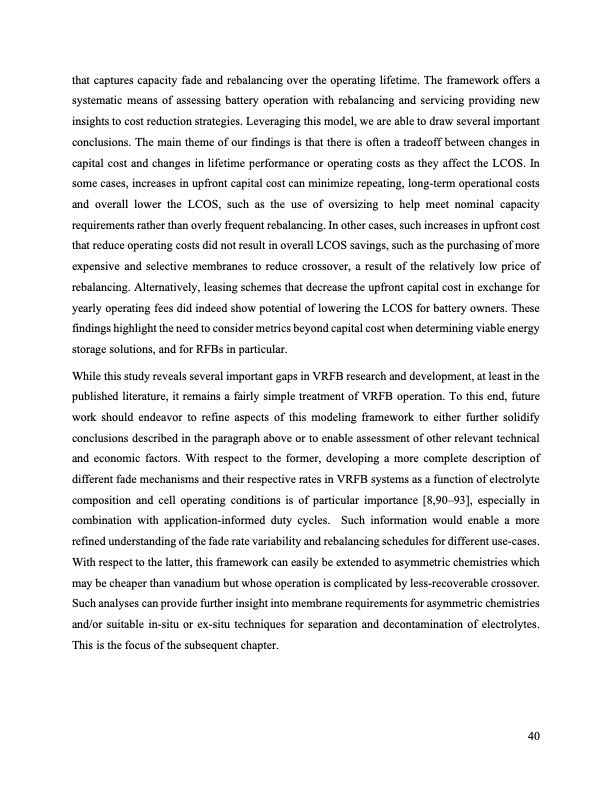
PDF Publication Title:
Text from PDF Page: 040
that captures capacity fade and rebalancing over the operating lifetime. The framework offers a systematic means of assessing battery operation with rebalancing and servicing providing new insights to cost reduction strategies. Leveraging this model, we are able to draw several important conclusions. The main theme of our findings is that there is often a tradeoff between changes in capital cost and changes in lifetime performance or operating costs as they affect the LCOS. In some cases, increases in upfront capital cost can minimize repeating, long-term operational costs and overall lower the LCOS, such as the use of oversizing to help meet nominal capacity requirements rather than overly frequent rebalancing. In other cases, such increases in upfront cost that reduce operating costs did not result in overall LCOS savings, such as the purchasing of more expensive and selective membranes to reduce crossover, a result of the relatively low price of rebalancing. Alternatively, leasing schemes that decrease the upfront capital cost in exchange for yearly operating fees did indeed show potential of lowering the LCOS for battery owners. These findings highlight the need to consider metrics beyond capital cost when determining viable energy storage solutions, and for RFBs in particular. While this study reveals several important gaps in VRFB research and development, at least in the published literature, it remains a fairly simple treatment of VRFB operation. To this end, future work should endeavor to refine aspects of this modeling framework to either further solidify conclusions described in the paragraph above or to enable assessment of other relevant technical and economic factors. With respect to the former, developing a more complete description of different fade mechanisms and their respective rates in VRFB systems as a function of electrolyte composition and cell operating conditions is of particular importance [8,90–93], especially in combination with application-informed duty cycles. Such information would enable a more refined understanding of the fade rate variability and rebalancing schedules for different use-cases. With respect to the latter, this framework can easily be extended to asymmetric chemistries which may be cheaper than vanadium but whose operation is complicated by less-recoverable crossover. Such analyses can provide further insight into membrane requirements for asymmetric chemistries and/or suitable in-situ or ex-situ techniques for separation and decontamination of electrolytes. This is the focus of the subsequent chapter. 40PDF Image | Bringing Redox Flow Batteries to the Grid

PDF Search Title:
Bringing Redox Flow Batteries to the GridOriginal File Name Searched:
Rodby-krodby-phd-chemE-2022-thesis.pdfDIY PDF Search: Google It | Yahoo | Bing
Salgenx Redox Flow Battery Technology: Salt water flow battery technology with low cost and great energy density that can be used for power storage and thermal storage. Let us de-risk your production using our license. Our aqueous flow battery is less cost than Tesla Megapack and available faster. Redox flow battery. No membrane needed like with Vanadium, or Bromine. Salgenx flow battery
| CONTACT TEL: 608-238-6001 Email: greg@salgenx.com | RSS | AMP |